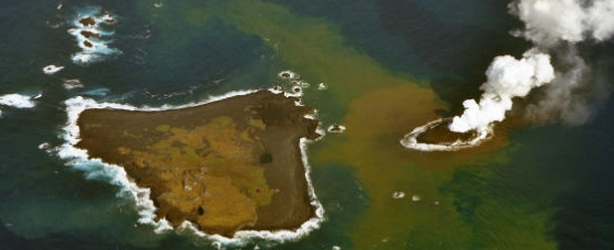Niijima – newly emerged Japanese island is growing, eruption still in progress

Japanese coast guard reported yesterday that newly emerged volcanic island near Nishino-shima (Ogasawara/Bonin) is still growing. The island was named Niijima and if continues to grow, it is expected to merge with Nishino-shima.
Volcanic activity is still in progress today, lava streams and smoke rising 2000 m were seen on images from December 2, 2013.
This new island emerged as a result of a Surtseyan eruption (volcanic eruption that takes place in shallow seas or lakes) on November 20, 2013, 500 m SE from the coast of Nishimo-shima. On November 21, when it was discovered, the new island was already about 300 x 200 m, and it developed a 150 m wide crater .
In this video, from December 2, it is said that the island had already grown to 2.5 the size from its first discovery on November 21, mainly to the east. (ER).
Pictures taken by the Japanese coast guard on November 21 showed clouds of heavy smoke, billowing steam, and waters rolling over the newly formed crater:

Video published on November 21, 2013. Courtesy: RT
On November 24 lava flows from the crater extended to the coastline of the island, and bombs continued to be ejected.


Video published on November 24, 2013. Courtesy: 朝日新聞社
November 27th, NHK report:


Video courtesy: NHK
The Ogasawara Islands were formed around 48 million years ago. They are a part of the Izu-Bonin-Mariana Arc known geologically as a fore arc. They lie above a subduction zone between the Pacific Plate and the Philippine Sea Plate.
The Pacific Plate is subducting under the Philippine Sea Plate, which creates an oceanic trench to the east of the islands. The crust of the Ogasawara (Bonin) Islands was formed by volcanic activity when subduction began 45–50 million years ago, and is composed mostly of an andesitic volcanic rock called boninite, which is rich in magnesium oxide, chromium, and silicon dioxide.
The last time the volcanoes in that area are known to have erupted was in the mid-1970's. Much of the volcanic activity occurs under the sea, which extends thousands of meters deep along the Izu-Ogasawara-Marianas Trench.
Featured image: An erupting undersea volcano forms a new island, shown by its nearest neighbour, Nishinoshima, a small uninhabited island in the southern Ogasawara chain of islands. Image taken on November 21, 2013. Image credit: Japanese Coast Guard.

i hope thise vulcano will help to clean the waters around
by releasing the zeolits,as God wants